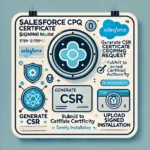Salesforce AppExchange is the world’s leading enterprise cloud marketplace, offering a vast array of third-party apps that extend the functionality of Salesforce CRM (Customer Relationship Management) and other Salesforce products. For developers and businesses, publishing an app on AppExchange opens doors to a global audience of Salesforce users, providing opportunities for growth, revenue generation, and enhancing customer experience.
Table of Contents
ToggleWhy Build a Salesforce AppExchange Apps?
Building a Salesforce AppExchange app can be highly beneficial for developers and businesses alike. It allows developers to showcase their innovation and technical prowess while businesses can leverage these apps to streamline operations, enhance productivity, and achieve specific business objectives within the Salesforce ecosystem. Whether you’re aiming to solve a unique business problem, integrate with other systems, or tap into new markets, publishing an app on AppExchange can significantly boost your Salesforce strategy.
Key Steps to Build a Salesforce AppExchange Apps
Building a Salesforce AppExchange app involves a structured process that encompasses planning, development, testing, security compliance, and publishing. Here’s a detailed walkthrough of each step:
1. Identify Market Needs and Define App Idea
Before diving into development, it’s crucial to conduct thorough market research to identify gaps or opportunities within the Salesforce ecosystem. This involves:
- Market Analysis: Assessing the demand for specific functionalities or solutions among Salesforce users.
- Defining Value Proposition: Clearly defining what makes your app unique and how it addresses identified market needs.
2. Salesforce Development Environment Setup
Setting up your development environment is the first practical step towards building your AppExchange app. Here’s what you need to do:
- Salesforce Developer Account: Sign up for a Salesforce Developer Edition account if you haven’t already. This provides you with a dedicated environment for development and testing.
- Development Tools: Install and configure necessary tools such as Salesforce CLI (Command Line Interface), IDE (Integrated Development Environment) like VS Code, and Git for version control.
3. Design and Architecture
Data Model Design:
Define the data model that your app will use, including Salesforce objects, fields, relationships, and any custom metadata types required. Consider scalability and performance factors while designing the data model.
User Interface (UI/UX) Design:
Create wireframes and mockups to visualize the user interface (UI) and user experience (UX) of your app. Use Salesforce Lightning Design System (SLDS) components for a consistent look and feel.
4. App Development
Once you have a clear plan and environment set up, proceed with app development:
Use Salesforce App Builder:
Develop the app’s UI and workflow using Salesforce App Builder, a point-and-click tool that allows you to customize Salesforce pages and components without code.
Apex and Lightning Components:
For more complex functionalities and backend logic, use Apex (Salesforce’s proprietary programming language) to write controllers, triggers, and other backend processes. Utilize Lightning Components for frontend customization and interactivity.
5. Testing and Quality Assurance
Unit Testing:
Write and execute unit tests using Apex to ensure the functionality and behavior of your code components.
User Acceptance Testing (UAT):
Engage stakeholders and end-users in UAT to gather feedback, ensure usability, and validate that the app meets business requirements.
6. Security and Compliance
Secure Coding Practices:
Adhere to Salesforce’s security best practices throughout the development process to prevent vulnerabilities such as cross-site scripting (XSS) and data leakage.
Security Review:
Submit your app for Salesforce’s security review, which includes rigorous testing to verify compliance with security standards and guidelines. This step is critical for gaining trust and approval from potential users.
7. Publishing on Salesforce AppExchange
Listing Creation:
Once your app passes the security review, create a compelling listing on Salesforce AppExchange:
- Write a detailed app description highlighting key features, benefits, and use cases.
- Include high-quality screenshots, videos, and customer testimonials to showcase your app’s value proposition.
- Set pricing options and subscription models based on your business strategy.
Go-Live:
After completing the listing creation, publish your app on Salesforce AppExchange. Users can now discover, install, and start using your app to enhance their Salesforce experience.
Tips for Success
– Continuous Improvement: Monitor user feedback and analytics post-launch to iterate and improve your app continuously.
– Marketing and Promotion: Utilize Salesforce AppExchange features like AppExchange Partner Program benefits, participate in Salesforce events and webinars, and engage with Salesforce Community groups to market your app effectively.
– Customer Support: Offer responsive customer support to address user queries, issues, and feature requests promptly.
External Links and Resources
Frequently Asked Questions (FAQs)
1. What is required to become a Salesforce AppExchange partner?
To become a Salesforce AppExchange partner, you need a Salesforce Developer Edition account, a well-developed app meeting Salesforce guidelines, and passing the Salesforce security review.
2. How long does it take to get an app listed on Salesforce AppExchange?
The time taken to list an app on Salesforce AppExchange varies. It typically involves app development, testing, security review (which can take a few weeks), and listing creation.
3. What are the costs associated with listing an app on Salesforce AppExchange?
There is a one-time security review fee (ranging from $2,700 to $5,000 depending on app complexity) and an annual AppExchange Partner Program fee (varies based on partnership level).
4. Can I sell my app on Salesforce AppExchange?
Yes, you can sell your app on Salesforce AppExchange. Salesforce manages transactions and collects a percentage of revenue (typically 15-25%) based on your partnership agreement.
5. How can I market my app on Salesforce AppExchange?
You can market your app through various channels including Salesforce AppExchange listing optimization, social media, email campaigns, webinars, and engaging with Salesforce Community groups.
6. What are the key factors for a successful Salesforce AppExchange app?
Successful factors include addressing a specific market need, user-friendly design, robust functionality, strong security, effective marketing, and responsive customer support.
Conclusion
Building a Salesforce AppExchange app requires meticulous planning, skillful development, adherence to Salesforce guidelines, and effective marketing strategies. By following the steps outlined in this guide and leveraging the resources provided, you can create a successful app that not only meets market demands but also enhances the Salesforce experience for users worldwide. Start your journey today to tap into the thriving ecosystem of Salesforce AppExchange and unlock new opportunities for growth and innovation.


